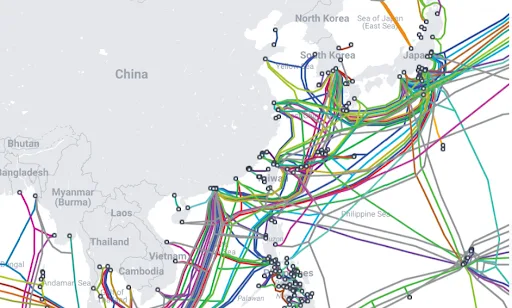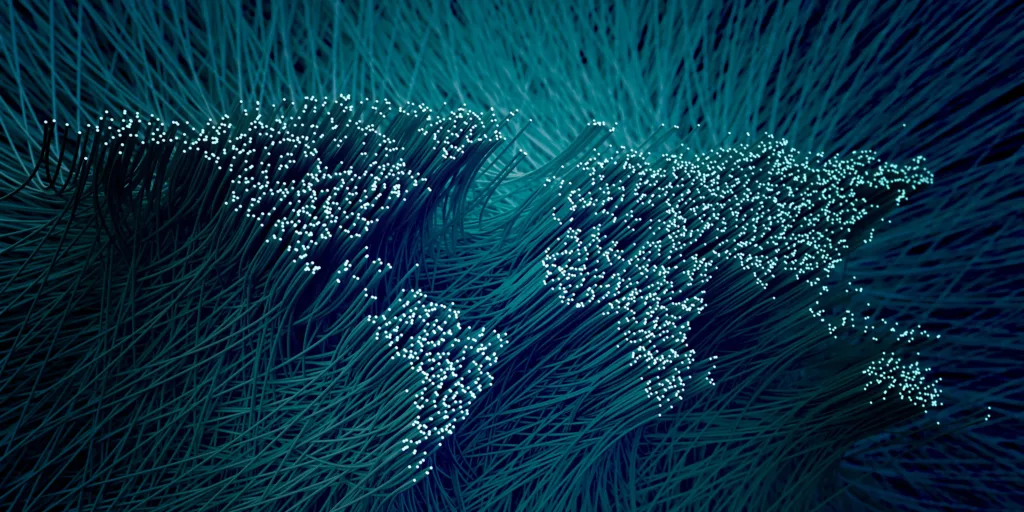Technological advancements point to the growing risk to underwater infrastructure from China.
Key takeaways:
-
Recent reports regarding China’s deep-sea cable-cutting technology indicate an emerging trend toward the militarization of critical digital infrastructure.
-
Current international legal frameworks, including the United Nations Convention on the Law of the Sea (UNCLOS), do not provide sufficient protection for submarine cables, particularly in international waters, where enforcement mechanisms are lacking.
-
Submarine cables around Taiwan and the Baltic region remain vulnerable to disruption, posing significant risks to communication and economic stability in contested geopolitical areas.
Subsea fiber optic cables form the backbone of global communication, carrying approximately 99% of intercontinental data traffic and enabling international trade, cooperation, and digital connectivity. These cables are critical to the stability of global communication networks and the digital economy, serving as essential links for both developed and developing regions. As digital technologies, artificial intelligence, and international data exchanges rapidly evolve, these cables have become increasingly viewed as strategic assets, intensifying concerns over their security and control amid rising geopolitical tensions.
China’s technological breakthrough?
In March, the South China Morning Post reported on a potential Chinese breakthrough in deep-sea cable-cutting technology, drawing international attention to the security of undersea infrastructure. The report was based off a research paper first published in the Mechanical Engineer journal by China Ship Scientific Research Centre in cooperation with the State Key Laboratory of Deep-Sea Manned Vehicles, which described the device as being capable of cutting heavily armored underwater communication cables at depths up to 4,000 meters—far beyond the operational range of most existing subsea infrastructure, typically laid between 1,500 and 2,000 meters.
The device, reportedly still in the testing phase, features a titanium alloy chassis for durability under extreme pressure and a diamond-coated grinding wheel capable of slicing through steel-reinforced, rubber-sheathed, and polymer-encased cables. These are precisely the types of cables that transmit approximately 95% of global internet traffic.
Currently, the prototype is limited to a 5.14 kg device, with testing conducted only in a water tank. Although the design incorporates calculated pressure compensation via an oil-filled cable, enabling operation at depths of up to 4,000 meters, this capability remains hypothetical until verified by deep-sea testing. Moreover, the research paper focused on the design and experimental validation of the cutting device itself. The potential integration with other underwater vehicles was not discussed in detail, although the use of an underwater manipulator during testing suggests possible future applications or remains a subject of speculation.
A rising concern
China’s progress in deep-sea technology is well-documented, exemplified by the advanced crewed and uncrewed submersibles Fendouzhe and Haidou, which have been used for both scientific and strategic purposes. But the potential deployment of deep-sea cable-cutting technology could significantly escalate hybrid warfare capabilities, with profound implications for global power dynamics. This threat is not merely theoretical. Recent disruptions of submarine cables around Taiwan and in the Baltic Sea underscore the growing risk to critical infrastructure.
Cable cutting as a component of grey warfare is not new. During World War I, Britain severed Germany’s transatlantic telegraph cables to isolate it from its overseas colonies. Similarly, during the Cold War, the United States tapped undersea cables to monitor Soviet communications. In the contemporary era, such tactics could be deployed alongside economic, military, and cyber operations. With these capabilities, China could disrupt the digital world within seconds, which would have implications not only for cybersecurity, military command chains, and fintech but also for civilians.
Chinese media, such as Baidu, emphasize that China’s technological advancements in deep-sea operations contribute to the safety and stability of the international submarine cables infrastructure. Beijing also claims to be actively implementing measures to minimize disruptions caused by maritime activities and enhance its ability to quickly mobilize resources for timely repairs, ensuring the smooth operation of the global communication infrastructure.
Patchy legal framework
The protection of undersea cables is governed by a combination of international treaties and conventions, which establish rules for preventing damage, ensuring maintenance, and resolving disputes. All states have the right to lay submarine cables on the high seas as well as in the exclusive economic zone and continental shelves of coastal states.
The 1884 Paris Convention prohibits willful or negligent damage to submarine cables but offers limited protection against accidental damage. More recent treaties, such as the 1958 Geneva Conventions and the 1982 United Nations Convention on the Law of the Sea (UNCLOS), expand protections by affirming the freedom to lay and maintain submarine cables and requiring states to enact laws penalizing cable damage. However, concerns persist regarding the adequacy and enforcement of legal protections of submarine cables, given their critical role in global communications and commerce.
To address these issues, the UN International Telecommunication Union has established a new body to enhance the protection of submarine cables, aiming to increase their resistance to damage and expedite repairs. However, the existing frameworks do not adequately address the emerging threat of state-sponsored sabotage or hybrid warfare, creating a pressing need for more comprehensive international regulations.
Challenges in detecting and preventing sabotage of the undersea cables
The vast scale and remote locations of undersea cables make continuous monitoring and rapid response challenging. These cables spread thousands of kilometers across the ocean floor, often in deep-sea areas where surveillance is minimal. Therefore, identifying perpetrators of sabotage is a complex task. Moreover, determining whether the disruption is accidental or intentional requires significant investigation.
Technological limitations further complicate protection efforts. Despite advancements in Autonomous Underwater Vehicles and Remotely Operated Vehicles, they provide limited coverage and cannot fully safeguard the extensive global network of cables. Moreover, international legal frameworks pose enforcement challenges, particularly in international waters where jurisdiction is unclear, making it difficult to establish and uphold protective measures.
Compounding this issue, the locations of most undersea cables are publicly accessible, making them vulnerable to sabotage. Websites like Submarine Cable Map provide detailed, real-time information on global cable networks, making it an easy target for anyone, including potential perpetrators, to track their routes. In contrast, military and espionage-related cables are typically classified, meaning their existence and locations remain undisclosed to the public.
Undersea cables are physically vulnerable, not only to intentional sabotage but also to accidental damage from fishing activities, ship anchors, and natural disasters. Repairing damaged cables is a costly and time-consuming endeavor, with repair costs typically ranging from $1 million to $3 million, and some disruptions taking even weeks to resolve. These expenses encompass specialized cable ships, highly trained crews, and replacement materials. This makes intentional damage to cables an effective method for disrupting communications and financial networks on a large scale with immediate effect.
Implications for Taiwan and the South China Sea
In any Cross-Strait conflict, Taiwan’s telecommunication cables would be at significant risk. The island relies on at least ten undersea cables and eight cable landing stations connecting Taiwan with the outside world. For instance, key hubs like the Yilan station at Toucheng connect Taipei with Japan, China and North America. The Pingtung station at Fangshan in the south connects Taiwan with Southeast Asia and Australia. Disrupting these strategic cables and landing stations could cripple Taiwan’s economy, sever communications with major trading partners and security allies, and send shockwaves through global markets. Countries such as Japan, South Korea, Singapore, and Indonesia, which rely on stable regional connectivity, would also face severe financial and operational disruptions.

China has already engaged in a range of grey zone tactics to undermine Taiwan’s autonomy, weaken its defence capabilities, and ultimately force unification. These activities include frequent military aircraft incursions, large-scale military drills near Taiwan, economic coercion, and massive cyberattacks on critical infrastructure. Disrupting undersea cables could be a strategic move to weaken Taiwan before any kinetic warfare begins. Notably, these actions may not be directly carried out by the People’s Liberation Army, but rather by Chinese nominally civilian assets such as fishing vessels or maritime research ships, allowing for plausible deniability. This makes it difficult for Taiwan and its allies to respond effectively, as these hybrid tactics are harder to trace and attribute.
Recent incidents underscore the vulnerability of Taiwan’s undersea cables. In February 2023, Chinese maritime vessels severed cables connecting Taiwan with the Matsu islands, disrupting Internet access. In early 2025, Xingshun 39, a Tanzanian-flagged vessel, severed subsea cables near Keelung, while Hong Tai 58, a Togolese-registered vessel with a suspected Chinese crew, damaged another cable linking Penghu and Taiwan. Taiwanese prosecutors have charged the captain of the Hong Tai 58 with intentionally damaging undersea cables, marking the first case of its kind. This action sets a precedent for how nations can effectively respond to grey-zone tactics through legal and strategic means in the future.
Incidents such as balloon overflights, sand dredging, and submarine cable disruptions test Taiwan’s resilience and its ability to respond to hybrid threats. Repairing such cables is time-consuming and costly, and developing a rapid response mechanism could take years.
Technological advancements are key for building Taiwan’s resilience. The Submarine Cable Automatic Warning System, deployed on the Taiwan-Matsu cables and other select international submarine cables, automatically sends alerts to nearby ships, warning them of the cable’s location to prevent accidental damage caused by anchors.
Beyond Taiwan, similar tactics could be deployed in the South China Sea, where critical undersea infrastructure supports regional economies and military operations. Cutting these cables would enable China to exert greater control over contested waters while undermining the digital and economic stability of rival claimants. While these “grey zone” tactics are aggressive and pose a significant challenge to regional security and global economic stability, they remain below the official threshold of what would be considered open warfare.
The growing Sino-Russian collaboration poses yet another significant threat. Both China and Russia have increasingly turned to non-traditional military strategies to undermine the security and economy of their adversaries, with undersea cable sabotage serving as a prime example. This involves direct sabotage or covert operations conducted by proxy entities, such as commercial vessels or fishing boats, which could damage or sever cables while avoiding attribution to state actors.
Recent suspicious activities conducted by the merchant vessels Shunxing-39 and Vasili Shukshin in the vicinity of Taiwan in early 2025 suggest possible collaboration between Chinese and Russian merchant ships related to the reconnaissance and sabotage of undersea communications cables that connect Taiwan to the outside world. Additionally, the October 2023 Balticconnector incident implicated Chinese merchant vessels, with further indications suggesting coordination with Russian maritime assets. These events serve as a clear example of China’s growing involvement in the maritime domain outside of the South China Sea and an increase in Sino-Russian collaboration in targeting undersea infrastructure.
Conclusion
The growing militarization of undersea infrastructure underscores its strategic importance in cybersecurity, hybrid warfare and global power competition. China’s significant investment in undersea technology, including submarines and cable-cutting technology, can be viewed as a form of strategic signaling, revealing its long-term ambitions.
As global reliance on subsea cables continues to grow, protecting the critical infrastructure has shifted from being merely a commercial concern to becoming a national strategic priority. Submarine cables are owned and operated by multinational consortia, consisting of between four and 40 entities, each with a percentage ownership stake in the cables. Currently, about 98% of the world’s undersea cables are manufactured and installed by four private companies: SubCom (US), Alcatel Submarine Networks (France), Nippon Electric Company (Japan), and HMN Technologies (China, formerly Huawei Marine Networks). Meanwhile, tech giants such as Amazon, Google, Meta, and Microsoft are playing increasingly dominant roles in both the operation and ownership of these networks. Google, for example, has partial stakes in more than a dozen submarine cables (the complete list of submarine cable holdings can be found here). These ownership consortia are responsible for the construction and maintenance of the cables, based on their share of the cables’ capacity.
The heavy concentration of control within the private sector highlights a significant vulnerability, particularly in the context of geopolitical tensions. The responsibility for the security and oversight of this infrastructure can no longer lie solely with commercial entities; governments must take a more active role in safeguarding these assets and developing deterrent mechanisms.
For instance, Taiwan provides an example of such proactive involvement, as authorities recently prosecuted the captain of the Hong Tai 58 vessel for intentionally damaging an undersea cable, marking the first formal investigation and prosecution of sabotage. This case underscores the critical need for state-level enforcement mechanisms and international cooperation. Additionally, it could help deter future attempts to intentionally damage subsea infrastructure, sending a clear message that these acts will be met with serious consequences.
The rise in Sino-Russian collaboration adds further risk, as both countries increasingly employ grey-zone tactics to test the resilience of international norms and the response thresholds of targeted states. As these tactics become more sophisticated and frequent, the need for coordinated monitoring, intelligence sharing, and unified responses among nations becomes increasingly urgent.






